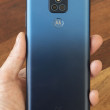ToF
Time of Flight
In phones, time-of-flight refers to a category of sensors that measure the precise distance between the sensor (in the phone) and external objects in front of the sensor. The measurement is made by emitting a special invisible beam (usually light, but can also be sound) and measuring the time it takes for that signal to make the round-trip from the sensor to the object and back, reflecting off the object.
The most advanced ToF sensors employ special cameras to make thousands of ToF measurements at once, generating a relatively accurate 3D map of objects in front of the sensor. This can be used for facial recognition as well as AR (augmented reality) applications.
See: AR
Simpler ToF sensors only make a single distance measurement, directly in front of the sensor. These also have applications in phones as proximity sensors, or camera focus sensors.
Last updated Nov 13, 2020 by Rich Brome
Editor in Chief Rich became fascinated with cell phones in 1999, creating mobile web sites for phones with tiny black-and-white displays and obsessing over new phone models. Realizing a need for better info about phones, he started Phone Scoop in 2001, and has been helming the site ever since. Rich has spent two decades researching and covering every detail of the phone industry, traveling the world to tour factories, interview CEOs, and get every last spec and photo Phone Scoop readers have come to expect. As an industry veteran, Rich is a respected voice on phone technology of the past, present, and future.



